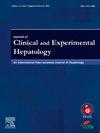Prognostic Value of the ASAP Score for Patients Undergoing Hepatic Resection for Hepatocellular Carcinoma: A Multicenter Analysis of 1,239 Patients
IF 3.3
Q2 GASTROENTEROLOGY & HEPATOLOGY
Journal of Clinical and Experimental Hepatology
Pub Date : 2024-12-31
DOI:10.1016/j.jceh.2024.102497
引用次数: 0
Abstract
Background and aims
The ASAP score, which incorporates age, sex, alpha-fetoprotein (AFP), and protein induced by vitamin K absence-II, has demonstrated promise for early detection of hepatocellular carcinoma (HCC). However, its prognostic value after HCC treatment remains unknown. The current study sought to evaluate the prognostic value of the ASAP score to predict recurrence and survival following curative hepatic resection for HCC.
Methods
This study using prospectively collected data included HCC patients who underwent curative-intent hepatic resection. The ASAP score was calculated preoperatively, and X-tile analysis was used to determine the optimal cutoff value. Univariate and multivariate analyses were performed to identify independent risk factors associated with recurrence and overall survival (OS).
Results
Among 1239 patients in the analytic cohort, the optimal ASAP score cutoff was 4.8; patients were divided into low (n = 749) and high (n = 490) ASAP score subgroups. Patients with high ASAP scores had a higher incidence of 5-year recurrence (73.9% vs 51.0%, P < 0.001) and worse OS (31.7% vs 60.1%, P < 0.001) versus individuals with low scores. Multivariate analysis identified ASAP score ≥4.8 as an independent risk factor of both recurrence (hazard ratio [HR] 1.976, 95% confidence interval [CI]: 1.633–2.390, P < 0.001) and OS (HR 1.407, 95% CI 1.170–1.691, P < 0.001) after controlling for established clinicopathological factors.
Conclusion
Preoperative ASAP score was independently associated with recurrence and survival after HCC resection. The clinical utility of the ASAP score may be applicable to both diagnosis and prognosis, potentially improving postoperative surveillance and management strategies for HCC patients.

1239例肝癌肝切除术患者ASAP评分的预后价值:多中心分析
背景和目的ASAP评分包含年龄、性别、甲胎蛋白(AFP)和维生素K缺失- ii诱导的蛋白,已被证明有望用于肝细胞癌(HCC)的早期检测。然而,其在HCC治疗后的预后价值尚不清楚。目前的研究旨在评估ASAP评分在肝癌根治性肝切除术后预测复发和生存的预后价值。方法本研究采用前瞻性收集的数据,包括接受治疗目的肝切除术的HCC患者。术前计算ASAP评分,采用x片分析确定最佳临界值。进行单因素和多因素分析,以确定与复发和总生存期(OS)相关的独立危险因素。结果1239例分析队列患者中,最佳ASAP评分临界值为4.8;将患者分为低(n = 749)和高(n = 490)两组。ASAP评分高的患者5年复发率较高(73.9% vs 51.0%, P <;0.001)和更差的OS (31.7% vs 60.1%, P <;0.001)与得分低的个体相比。多因素分析发现,ASAP评分≥4.8是两种复发的独立危险因素(危险比[HR] 1.976, 95%可信区间[CI]: 1.633-2.390, P <;0.001)和OS (HR 1.407, 95% CI 1.170-1.691, P <;0.001),在控制了既定的临床病理因素后。结论术前ASAP评分与肝细胞癌术后复发及生存独立相关。ASAP评分的临床应用可能适用于HCC患者的诊断和预后,潜在地改善HCC患者的术后监测和管理策略。
本文章由计算机程序翻译,如有差异,请以英文原文为准。
求助全文
约1分钟内获得全文
求助全文
来源期刊

Journal of Clinical and Experimental Hepatology
GASTROENTEROLOGY & HEPATOLOGY-
CiteScore
4.90
自引率
16.70%
发文量
537
审稿时长
64 days
 求助内容:
求助内容: 应助结果提醒方式:
应助结果提醒方式:


